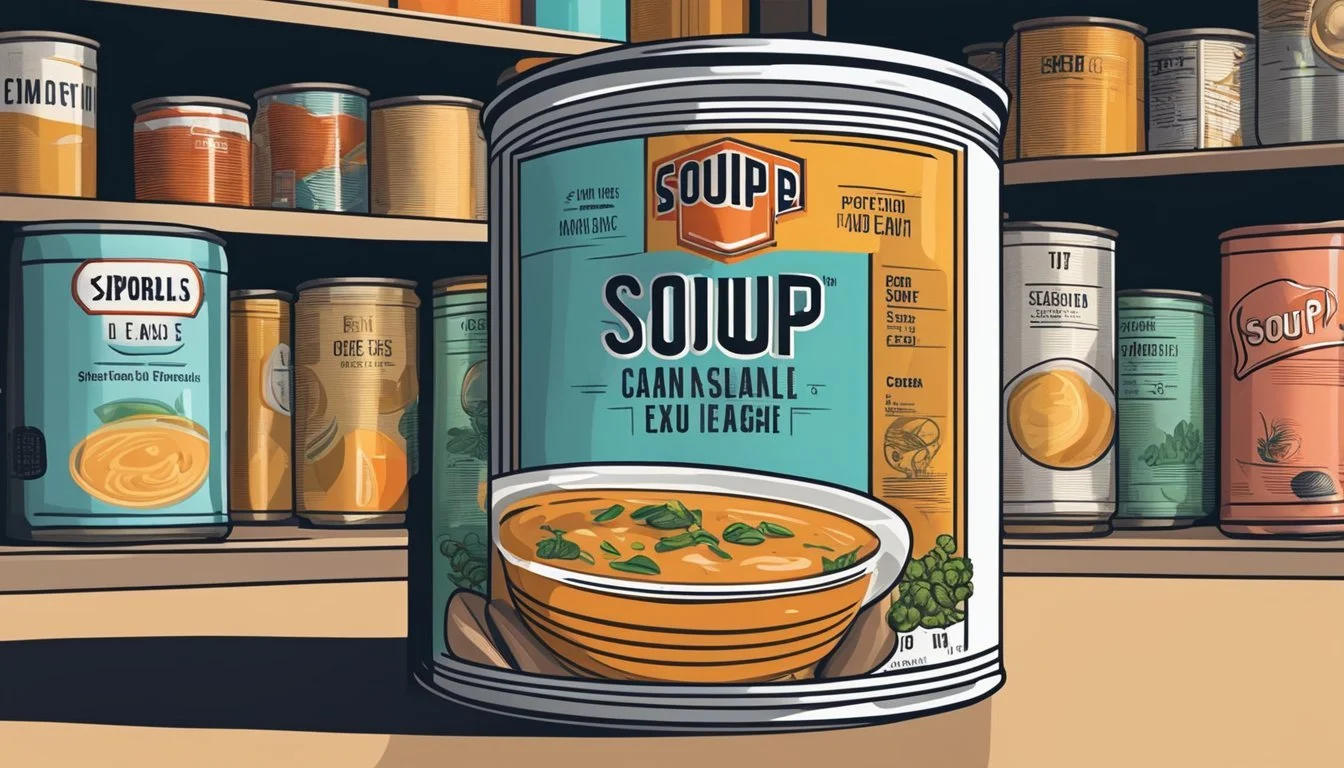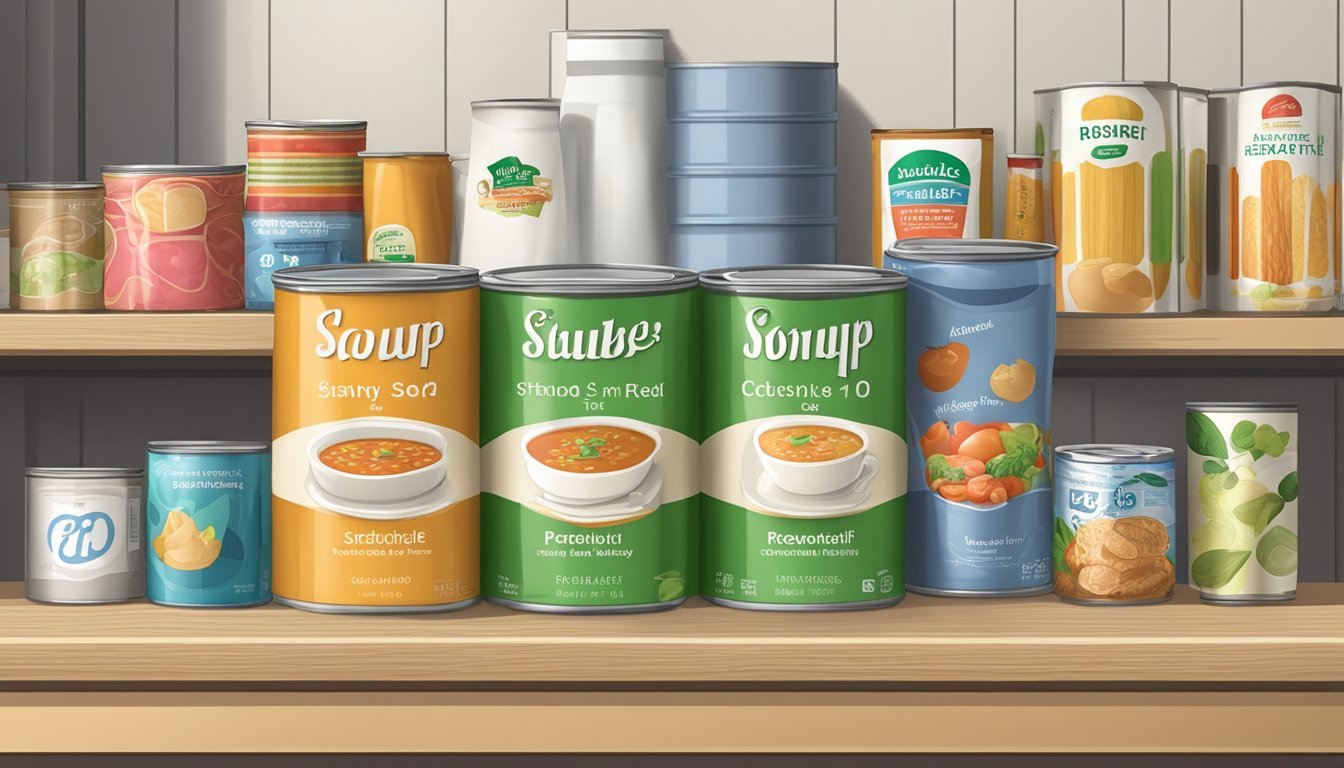Does Canned Soup Go Bad?
Understanding Shelf Life and Safety
Canned soup is a staple in many households due to its convenience and long shelf life. Unopened canned soups generally maintain their quality for 2 to 5 years when stored under optimal conditions. These conditions include a cool, dark place with low humidity, which ensures the contents remain safe and consumable.
Spoilage in canned soup can occur if the can is damaged or exposed to adverse conditions. If a can is punctured or rusted, it should be discarded. An open can of soup will spoil much faster, typically within a few days when refrigerated.
Food safety is paramount when consuming canned foods past their expiration date. While many canned soups remain edible beyond this date, always check for signs of spoilage like an off smell, bulging can, or unusual appearance. Taking these precautions helps ensure a safe and enjoyable meal.
Understanding Canned Soup Shelf Life
The shelf life of canned soup depends on several factors, including different labeling terms, storage conditions, and the type of ingredients. Proper storage and understanding these labels can help in maintaining the quality and safety of canned soups.
Decoding Expiration Labels
Expiration labels on canned soup can be confusing. These labels include best-by, sell-by, and expiration dates, each serving a different purpose.
Best-by dates indicate the period during which the manufacturer guarantees peak quality.
Sell-by dates are intended for retailers to know how long to display the product.
Expiration dates suggest when the product may no longer be safe to consume.
Most unopened canned soups can remain safe for consumption for 2 to 5 years if stored properly, despite passing these dates. It's crucial to assess the can for any signs of damage or spoilage, such as bulging, rust, or leaking.
Factors Influencing Longevity
Several factors influence the longevity of canned soups. These include storage conditions, the type of soup, and handling practices.
Storage Conditions:
Temperature: Cooler temperatures extend shelf life.
Light: Minimal exposure to light is ideal.
Humidity: Low humidity prevents rusting and spoilage.
Type of Soup:
Soups with vegetables like peas, corn, and green beans typically last 2 to 5 years.
Tomato-based soups may have different longevity due to their acidity.
Handling Practices:
Ensuring cans are not dented or compromised.
Once opened, transfer contents to airtight containers and refrigerate or freeze.
Proper care and attention to these factors can ensure the safety and quality of canned soups over extended periods.
Identifying Signs of Spoilage
To determine if canned soup has spoiled, it is essential to examine both visual and sensory indicators meticulously.
Visual Clues of Deterioration
Cans showing bulging, dents, rust, or leaking are strong indicators that the soup inside may not be safe to consume. These physical changes often suggest that the can's seal has been compromised, allowing bacteria to enter.
Another crucial visual clue is the appearance of the soup itself. A change in color or the presence of mold can indicate spoilage. If the soup looks unusually dark or has developed strange spots, it should be discarded. Containers that have been damaged have a higher risk of contamination.
Texture and Smell Changes
A spoiled canned soup often exhibits distinct changes in texture and smell. If the soup inside feels overly chunky, slimy, or has an unexpected consistency, it is likely spoiled. Texture alterations suggest microbial activity.
The odor of the soup can also provide valuable information. An unpleasant or sour smell is a surefire sign that the soup has gone bad. Trust your nose; if the soup smells off in any way, it is best to err on the side of caution and throw it away. Changes in texture and smell are clear indicators of bacterial growth or chemical reactions that render the soup unsafe.
Health Risks and Food Safety
Proper storage and handling of canned soup are crucial to prevent health risks such as botulism, food poisoning, and other foodborne illnesses.
Recognizing Botulism Threat
Botulism is a severe health risk associated with canned foods, including soup. Clostridium botulinum, the bacteria responsible, produces neurotoxins that cause muscle paralysis and can be fatal.
Symptoms of botulism include difficulty breathing, muscle weakness, and blurred vision. Contaminated cans often show signs such as bulging, rusting, or leaking. Always inspect cans before use, and discard any damaged or suspicious ones immediately.
Other Foodborne Illnesses
Aside from botulism, canned soup can also harbor other bacteria causing foodborne illnesses. Bacteria like Salmonella and Listeria thrive in improperly stored or handled canned foods.
Common symptoms of foodborne illnesses include nausea, vomiting, and diarrhea. Excessive sodium in some canned soups may also pose health risks, particularly for individuals with hypertension. Always store canned soup in a cool, dry place and check expiration dates to minimize health risks.
Proper Storage and Handling
Proper storage and handling of canned soup can significantly extend its shelf life and maintain quality. Key considerations include storage conditions and how the soup is handled before and after opening.
Before and After Opening
Unopened canned soups should be stored in a cool, dry place, such as a pantry, to ensure they remain in optimal condition. Extreme temperatures can compromise the integrity of the can, so avoid areas that are too hot or too cold.
Once a can is opened, transfer any leftover soup into an airtight container and store it in the refrigerator. This will help preserve the soup's flavor and prevent bacterial growth. Generally, opened canned soups should be consumed within 3-4 days for best quality.
Temperature and Condition Considerations
The storage area for canned soup should maintain a consistent temperature, ideally between 50°F and 70°F. Prolonged storage above 75°F can lead to nutrient loss and increase the risk of spoilage. Additionally, it's essential to keep the storage area dry to avoid rusting and compromising the can.
In conditions of high humidity, mold and mildew can develop, posing a risk to the soup's safety. To ensure longevity, regularly check for signs of can damage such as dents, rust, or swelling. If any of these are present, it is safer to discard the can to avoid potential health risks.
Nutritional Implications
The nutritional content of canned soup can be influenced by various factors, including the type of preservatives used and how well nutrients are retained over time.
Preservatives and Vitamins
Canned soups often rely on preservatives to extend shelf life. Common preservatives include sodium and citric acid. Sodium not only helps preserve the soup but also enhances its flavor. However, excessive sodium intake can lead to health issues like hypertension.
Vitamins, particularly B-vitamins and vitamin C, can degrade during the canning process. High heat can break down these nutrients, resulting in lower vitamin content. While some vitamins are lost, others like fat-soluble vitamins A and D tend to be more stable.
Consumers should check labels for added nutrients and low-sodium options to maintain a balanced diet.
Assessing Nutritional Value Over Time
The nutritional value of canned soup can decrease as it ages. Proteins and minerals are fairly stable but the quality of the soup can deteriorate, reducing its appeal. The soup may lose some taste and texture, and nutrient breakdown can continue over time.
To retain quality, canned soups should be stored in a cool, dry place. Checking expiration dates ensures consumption of the soup when its nutritional profile is still intact.
Canning is effective for long-term food preservation, but it's crucial to balance convenience with nutritional requirements. Opting for soups labeled with low sodium and no added preservatives can help mitigate some concerns related to canned food consumption.
Canned Soup Varieties and Considerations
Different types of canned soups have varying shelf lives, influenced primarily by their acidity levels. Proper storage conditions are crucial to maintaining the quality and safety of these foods.
Acidic Versus Low-Acid Soups
Acidic Soups:
Canned soups containing tomatoes or sauerkraut are more acidic. The acidity helps preserve the soup and typically results in a longer shelf life—up to 5 years if unopened. However, their taste and nutritional quality may slowly degrade over time.
Low-Acid Soups:
Canned soups with vegetables like corn, peas, and green beans, or meat-based stews, are low-acid. While these soups also last up to 5 years when stored correctly, their lower acidity makes them more susceptible to bacterial contamination once opened. Always inspect for any signs of spoilage before consumption, such as a strange odor or unusual color.
Storage Tips:
Cool Pantry: Keeps cans fresh until opened.
Refrigeration: Can help maintain quality for leftovers.
Inspect Cans: Avoid using dented, bulging, or leaking cans to prevent health risks.
Sustainable Practices and Donations
Donating canned soup and other shelf-stable foods not only helps fight hunger but also minimizes food waste. Safe donation practices ensure the proper handling and distribution of canned goods.
Safe Donation Guidelines
When donating canned goods to food banks and pantries, it is critical to follow safe donation guidelines. Unspoiled and non-expired canned goods are eligible for donation. This includes items like canned vegetables, canned meat, and spam.
Check expiration dates to ensure the food is still safe to consume. Donating expired food is not recommended as it may pose health risks. Proper storage during transport to the donation center is essential to prevent damage or spoilage. Use original packaging and avoid items with punctured or severely dented cans.
Food banks typically have specific guidelines on what they can accept. It is advisable to review these before donating. In the 2022 Food Code, the FDA confirmed that retailers could donate food, provided it follows safety protocols, including maintaining proper temperatures for perishable items.
Minimizing Waste
Donating canned goods can significantly help reduce food waste. Many individuals and retailers discard perfectly edible shelf-stable foods due to minor label damage or nearing "best by" dates.
Food banks and pantries accept these items, ensuring they are used rather than thrown away. On a larger scale, reducing waste from supermarkets and grocery stores can have a substantial impact. These establishments can partner with local shelters and soup kitchens to donate surplus inventory.
Consuming and donating foods like canned vegetables and meats, which have a longer shelf life, helps in effective inventory management. Awareness programs about minimizing waste through donations can encourage more people to contribute, thus supporting both the environment and communities in need.





